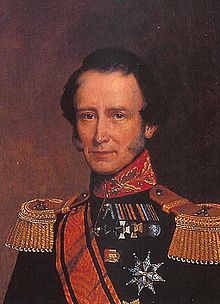Prince Frederik of the Netherlands
| Prince Frederick | |
|---|---|
 |
|
| Born |
28 February 1797 Berlin |
| Died | 8 September 1881 (aged 84) Wassenaar |
| Spouse | Princess Louise of Prussia |
| Issue |
Louise, Queen of Sweden and Norway Prince Frederik Prince Willem Marie, Princess of Wied |
| House | Orange-Nassau |
| Father | William I of the Netherlands |
| Mother | Wilhelmine of Prussia |
| Religion | Dutch Reformed Church |
Prince Frederick of the Netherlands, Prince of Orange-Nassau (full names: Willem Frederik Karel; Berlin, 28 February 1797 – Wassenaar, 8 September 1881), was the second son of William I of the Netherlands and his wife, Wilhelmine of Prussia.
The prince grew up at the court of his grandfather Frederick William II of Prussia and uncle Frederick William III of Prussia. One of his tutors was Carl von Clausewitz. Aged 16, the prince fought in the Battle of Leipzig.
The prince first entered the Netherlands in December 1813. As he spoke no Dutch, the prince was sent to Leiden University to get a further education. He was also educated by Karl Ludwig von Phull in The Hague. When Napoleon returned from Elba, during the Hundred Days the prince was given command of a detachment of Wellington's army which was posted in a fall back position near Braine-le-Comte should the battle taking place at Waterloo be lost.
Based on a house treaty, Frederick was to inherit the family's German possessions upon his father's death. After the treaty of Vienna these were no longer in the possession of the family. He instead was made heir to the Grand Duchy of Luxemburg. In 1816, Frederick relinquished this claim in exchange for land in the Netherlands and the title of Prince of the Netherlands. As a further compensation he received a yearly amount of 190,000 Dutch guilder. This made him the wealthiest member of the House of Orange-Nassau. With the money he bought a large estate in Germany, which made him the largest land owner from the Netherlands.
...
Wikipedia
